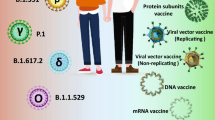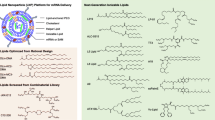Abstract
Virus-Like Particles (VLPs) have been used as immunogenic molecules in numerous recombinant vaccines. VLPs can also serve as vaccine platform to exogenous antigens, usually peptides incorporated within the protein sequences which compose the VLPs or conjugated to them. We herein described the conjugation of a synthetic tetrasaccharide mimicking the Streptococcus pneumoniae serotype 14 capsular polysaccharide to recombinant adenoviral type 3 dodecahedron, formed by the self-assembling of twelve penton bases and investigated the induced immune response when administered subcutaneously (s.c.). Whether formulated in the form of a dodecahedron or disassembled, the glycoconjugate induced an anti-protein response after two and three immunizations equivalent to that observed when the native dodecahedron was administered. On the other hand, the glycoconjugate induced a weak anti-IgM response which diminishes after two doses but no IgM-to-IgG switch was observed in mice against the serotype 14 capsular polysaccharide. In definitive, the whole conjugation process preserved both particulate nature and immunogenicity of the adenoviral dodecahedron. Further studies are needed to fully exploit adenoviral dodecahedron potential in terms of plasticity towards sequence engineering and of its capacity to stimulate the immune system via the intranasal route of administration as well as to shift the response to the carbohydrate antigen by playing both with the carbohydrate to protein ratio and the length of the synthetic carbohydrate antigen.





Similar content being viewed by others
Data availability
The datasets generated during and/or analysed during the current study are available from the corresponding author on reasonable request.
References
Heidelberger, M., Avery, O.T.: The soluble specific substance of pneumococcus. J. Exp. Med. 38(1), 73–79 (1923). https://doi.org/10.1084/jem.38.1.73
Rappuoli, R.: Glycoconjugate vaccines: Principles and mechanisms. Sci. Transl. Med. 10(456), 29 (2018). https://doi.org/10.1126/scitranslmed.aat4615
Sun, X., Stefanetti, G., Berti, F., Kasper, D.L.: Polysaccharide structure dictates mechanism of adaptive immune response to glycoconjugate vaccines. Proc. Natl. Acad. Sci. U S A. 116(1), 193–198 (2019). https://doi.org/10.1073/pnas.1816401115
Bröker, M., Berti, F., Schneider, J., Vojtek, I.: Polysaccharide conjugate vaccine protein carriers as a “neglected valency” - Potential and limitations. Vaccine. 35(25), 3286–3294 (2017). https://doi.org/10.1016/j.vaccine.2017.04.078
Micoli, F., Adamo, R., Costantino, P.: Protein Carriers for Glycoconjugate Vaccines: History, Selection Criteria, Characterization and New Trends. Molecules. 23(6), (2018). https://doi.org/10.3390/molecules23061451
Pinto, V.B., Burden, R., Wagner, A., Moran, E.E., Lee, C.-H.: The development of an experimental multiple serogroups vaccine for Neisseria meningitidis. PLoS One. 8(11), e79304 (2013). https://doi.org/10.1371/journal.pone.0079304
Grandjean, C., Wade, T.K., Ropartz, D., Ernst, L., Wade, W.F.: Acid-detoxified Inaba lipopolysaccharide (pmLPS) is a superior cholera conjugate vaccine immunogen than hydrazine-detoxified lipopolysaccharide and induces vibriocidal and protective antibodies. Pathog. Dis. 67(2), 136–158 (2013). https://doi.org/10.1111/2049-632X.12022
Woodruff, M.C., Kim, E.H., Luo, W., Pulendran, B.: B Cell Competition for Restricted T Cell Help Suppresses Rare-Epitope Responses. Cell. Rep. 25(2), 321–327.e3 (2018). https://doi.org/10.1016/j.celrep.2018.09.029
Pillot, A., Defontaine, A., Fateh, A., Lambert, A., Prasanna, M., Fanuel, M., Pipelier, M., Csaba, N., Violo, T., Camberlein, E., Grandjean, C.: Site-specific conjugation for fully controlled Glycoconjugate vaccine preparation. Front Chem. 7, 726 (2019). https://doi.org/10.3389/fchem.2019.00726
Gause, K.T., Wheatley, A.K., Cui, J., Yan, Y., Kent, S.J., Caruso, F.: Immunological Principles Guiding the Rational Design of Particles for Vaccine Delivery. ACS Nano. 11(1), 54–68 (2017). https://doi.org/10.1021/acsnano.6b07343
Cimica, V., Galarza, J.M.: Adjuvant formulations for virus-like particle (VLP) based vaccines. Clin. Immunol. 183, 99–108 (2017). https://doi.org/10.1016/j.clim.2017.08.004
Yan, D., Wei, Y.-Q., Guo, H.-C., Sun, S.-Q.: The application of virus-like particles as vaccines and biological vehicles. Appl. Microbiol. Biotechnol. 99(24), 10415–10432 (2015). https://doi.org/10.1007/s00253-015-7000-8
Marcandalli, J., et al.: Induction of Potent Neutralizing Antibody Responses by a Designed Protein Nanoparticle Vaccine for Respiratory Syncytial Virus. Cell. 176(6), 1420–1431.e17 (2019). https://doi.org/10.1016/j.cell.2019.01.046
Powell, A.E., Zhang, K., Sanyal, M., Tang, S., Weidenbacher, P.A., Li, S., Pham, T.D., Pak, J.E., Chiu, W., Kim, P.S.: A single immunization with spike-functionalized ferritin vaccines elicits neutralizing antibody responses against SARS-CoV-2 in mice. ACS Cent. Sci. 7(1), 183–199 (2021). https://doi.org/10.1021/acscentsci.0c01405
Sungsuwan, S., Wu, X., Huang, X.: Evaluation of virus-like particle-based tumor-associated carbohydrate Immunogen in a mouse tumor model. Methods Enzymol. 597, 359–376 (2017). https://doi.org/10.1016/bs.mie.2017.06.030
Astronomo, R.D., et al.: Defining criteria for oligomannose immunogens for HIV using icosahedral virus capsid scaffolds. Chem. Biol. 17(4), 357–370 (2010). https://doi.org/10.1016/j.chembiol.2010.03.012
Polonskaya, Z., et al.: T cells control the generation of nanomolar-affinity anti-glycan antibodies. J. Clin. Invest. 127(4), 1491–1504 (2017). https://doi.org/10.1172/JCI91192
Fender, P., Ruigrok, R.W., Gout, E., Buffet, S., Chroboczek, J.: Adenovirus dodecahedron, a new vector for human gene transfer. Nat Biotechnol. 15(1), 52–56 (1997). https://doi.org/10.1038/nbt0197-52
Vivès, R.R., Lortat-Jacob, H., Chroboczek, J., Fender, P.: Heparan sulfate proteoglycan mediates the selective attachment and internalization of serotype 3 human adenovirus dodecahedron. Virology. 321(2), 332–340 (2004). https://doi.org/10.1016/j.virol.2004.01.015
Fender, P., Schoehn, G., Perron-Sierra, F., Tucker, G.C., Lortat-Jacob, H.: Adenovirus dodecahedron cell attachment and entry are mediated by heparan sulfate and integrins and vary along the cell cycle. Virology. 371(1), 155–164 (2008). https://doi.org/10.1016/j.virol.2007.09.026
Naskalska, A., Szolajska, E., Andreev, I., Podsiadla, M., Chroboczek, J.: Towards a novel influenza vaccine: engineering of hemagglutinin on a platform of adenovirus dodecahedron. BMC Biotechnol. 13, 50 (2013). https://doi.org/10.1186/1472-6750-13-50
Szurgot, I., et al.: Self-adjuvanting influenza candidate vaccine presenting epitopes for cell-mediated immunity on a proteinaceous multivalent nanoplatform. Vaccine. 31(40), 4338–4346 (2013). https://doi.org/10.1016/j.vaccine.2013.07.021
Vragniau, C., Bufton, J. C., Garzoni, F., Stermann, E., Rabi, F., Terrat, C., Guidetti, M., Josserand, V., Williams, M., Woods, C.J., Viedma, G., Bates, P., Verrier, B., Chaperot, L., Schaffitzel, C., Berger, I., Fender, P. Synthetic self-assembling ADDomer platform for highly efficient vaccination by genetically encoded multiepitope display. Sci. Adv. 5(9), eaaw2853 (2019). https://doi.org/10.1126/sciadv.aaw2853
Szurgot, I., Jedynak, M., Podsiadla-Bialoskorska, M., Piwowarski, J., Szolajska, E., Chroboczek, J.: Adenovirus Dodecahedron, a VLP, Can be Purified by Size Exclusion Chromatography Instead of Time-Consuming Sucrose Density Gradient Centrifugation. Mol. Biotechnol. 57(6), 565–573 (2015). https://doi.org/10.1007/s12033-015-9850-9
Prasanna, M., et al.: Semisynthetic glycoconjugate based on dual role protein/PsaA as a pneumococcal vaccine. Eur. J. Pharm. Sci. 129, 31–41 (2019). https://doi.org/10.1016/j.ejps.2018.12.013
Herbert, D., Phipps, P. J., Strange, R. E., Chapter III Chemical Analysis of Microbial Cells. In: Methods in Microbiology, 5, J. R. Norris, D. W. Ribbons, Éd. Academic Press, 209–344 (1971). https://doi.org/10.1016/S0580-9517(08)70641-X
Grandjean, C., Boutonnier, A., Dassy, B., Fournier, J.-M., Mulard, L.A.: Investigation towards bivalent chemically defined glycoconjugate immunogens prepared from acid-detoxified lipopolysaccharide of Vibrio cholerae O1, serotype Inaba. Glycoconj J. 26(1), 41–55 (2009). https://doi.org/10.1007/s10719-008-9160-6
Fuschiotti, P., et al.: Structure of the dodecahedral penton particle from human adenovirus type 3. J. Mol. Biol. 356(2), 510–520 (2006). https://doi.org/10.1016/j.jmb.2005.11.048
Safari, D., et al.: Identification of the smallest structure capable of evoking opsonophagocytic antibodies against Streptococcus pneumoniae type 14. Infect. Immun. 76(10), 4615–4623 (2008). https://doi.org/10.1128/IAI.00472-08
Kurbatova, E.A., Akhmatova, N.K., Akhmatova, E.A., Egorova, N.B., Yastrebova, N.E., Sukhova, E.V., Yashunsky, D.V., Tsvetkov, Y.E., Gening, M.L., Nifantiev, N.E.: Neoglycoconjugate of Tetrasaccharide representing one repeating unit of the Streptococcus pneumoniae type 14 capsular polysaccharide induces the production of opsonizing IgG1 antibodies and possesses the highest protective activity as compared to Hexa- and Octasaccharide conjugates. Front. Immunol. 8, 659 (2017). https://doi.org/10.3389/fimmu.2017.00659
Pozsgay, V., Chu, C., Pannell, L., Wolfe, J., Robbins, J.B., Schneerson, R.: Protein conjugates of synthetic saccharides elicit higher levels of serum IgG lipopolysaccharide antibodies in mice than do those of the O-specific polysaccharide from Shigella dysenteriae type 1. Proc. Natl. Acad. Sci. U S A. 96(9), 5194–5197 (1999). https://doi.org/10.1073/pnas.96.9.5194
Carboni, F., et al.: Evaluation of Immune Responses to Group B Streptococcus Type III Oligosaccharides Containing a Minimal Protective Epitope. J. Infect. Dis. 221(6), 943–947 (2020). https://doi.org/10.1093/infdis/jiz551
Mawas, F., Niggemann, J., Jones, C., Corbel, M.J., Kamerling, J.P., Vliegenthart, J.F.G.: Immunogenicity in a mouse model of a conjugate vaccine made with a synthetic single repeating unit of type 14 pneumococcal polysaccharide coupled to CRM197. Infect. Immun. 70(9), 5107–5114 (2002). https://doi.org/10.1128/iai.70.9.5107-5114.2002
Milhomme, O., et al.: Synthesis and immunochemical evaluation of a non-methylated disaccharide analogue of the anthrax tetrasaccharide. Org. Biomol. Chem. 10(42), 8524–8532 (2012). https://doi.org/10.1039/c2ob26131f
Khurana, J.M., Gogia, A.: Synthetically Useful Reactions with Nickel Boride. a Review. Org. Preparations Proced. Int. 29(1), 1–32 (1997). https://doi.org/10.1080/00304949709355171
Pettersen, E.F., et al.: UCSF Chimera--a visualization system for exploratory research and analysis. J. Comput. Chem. 25(13), 1605–1612 (2004). https://doi.org/10.1002/jcc.20084
Szolajska, E., et al.: The structural basis for the integrity of adenovirus Ad3 dodecahedron. PLoS One. 7(9), e46075 (2012). https://doi.org/10.1371/journal.pone.0046075
Wang, X., et al.: Immune protection efficacy of FAdV-4 surface proteins fiber-1, fiber-2, hexon and penton base. Virus Res. 245, 1–6 (2018). https://doi.org/10.1016/j.virusres.2017.12.003
Bal, H.P., Chroboczek, J., Schoehn, G., Ruigrok, R.W., Dewhurst, S.: Adenovirus type 7 penton purification of soluble pentamers from Escherichia coli and development of an integrin-dependent gene delivery system. Eur J Biochem. 267(19), 6074–6081 (2000). https://doi.org/10.1046/j.1432-1327.2000.01684.x
« Default of the coating can be ruled out since a response has been observed for positive controls - positive sera from previous immunizations - which are added in every tested ELISA plate »
Peeters, C.C., Tenbergen-Meekes, A.M., Poolman, J.T., Zegers, B.J., Rijkers, G.T.: Immunogenicity of a Streptococcus pneumoniae type 4 polysaccharide--protein conjugate vaccine is decreased by admixture of high doses of free saccharide. Vaccine. 10(12), 833–840 (1992). https://doi.org/10.1016/0264-410x(92)90046-m
Rodriguez, M.E., et al.: Immunogenicity of Streptococcus pneumoniae type 6B and 14 polysaccharide-tetanus toxoid conjugates and the effect of uncoupled polysaccharide on the antigen-specific immune response. Vaccine. 16(20), 1941–1949 (1998). https://doi.org/10.1016/s0264-410x(98)00129-7
Ma, Z., Zhang, H., Wang, P.G., Liu, X.-W., Chen, M.: Peptide adjacent to glycosylation sites impacts immunogenicity of glycoconjugate vaccine. Oncotarget. 9(1), 75–82 (2018). https://doi.org/10.18632/oncotarget.19944
Pecetta, S., et al.: Carrier priming with CRM 197 or diphtheria toxoid has a different impact on the immunogenicity of the respective glycoconjugates: biophysical and immunochemical interpretation. Vaccine. 33(2), 314–320 (2015). https://doi.org/10.1016/j.vaccine.2014.11.026
Vinuesa, C.G., Linterman, M.A., Yu, D., MacLennan, I.C.M.: Follicular Helper T Cells. Annu. Rev. Immunol. 34, 335–368 (2016). https://doi.org/10.1146/annurev-immunol-041015-055605
Sterrett, S., et al.: Peripheral CD4 T follicular cells induced by a conjugated pneumococcal vaccine correlate with enhanced opsonophagocytic antibody responses in younger individuals. Vaccine. 38(7), 1778–1786 (2020). https://doi.org/10.1016/j.vaccine.2019.12.023
Hong, S., et al.: B Cells Are the Dominant Antigen-Presenting Cells that Activate Naive CD4+ T Cells upon Immunization with a Virus-Derived Nanoparticle Antigen. Immunity. 49(4), 695–708.e4 (2018). https://doi.org/10.1016/j.immuni.2018.08.012
Acknowledgments
MP acknowledges doctoral fellowship from the European Commission, Education, Audiovisual and Culture Executive Agency (EACEA), under the Erasmus Mundus program, NanoFar. NR thanks the Région Pays de la Loire, International Strategy Program “NanoFar+” for a travel grant. The authors gratefully acknowledge Anthony Piticco for its technical assistance, Dorian Caudal and Aude Lafoux from platform Therassey (Nantes) for animal experiments and Dr. Jadwiga Chroboczek for helpful discussion. This work used the EM facilities at the Grenoble Instruct-ERIC Center (ISBG; UMS 3518 CNRS CEA-UGA-EMBL) with support from the French Infrastructure for Integrated Structural Biology (FRISBI; ANR-10-INSB-05-02) and GRAL, a project of the University Grenoble Alpes graduate school (Ecoles Universitaires de Recherche) CBH-EUR-GS (ANR-17-EURE-0003) within the Grenoble Partnership for Structural Biology. The IBS Electron Microscope facility is supported by the Auvergne Rhône-Alpes Region, the Fonds Feder, the Fondation pour la Recherche Médicale and GIS-IBiSA. Finally, We also thank the mass spectrometry core facility of CRNH for exact mass determination.
Author information
Authors and Affiliations
Corresponding author
Ethics declarations
Conflict of interest
The authors declare that they have no conflicts of interest.
Ethical approval
The animal study was reviewed and approved by ethical permit number from Comité d’Ethique en Expérimentation Animale (CEEA): 7897.
Additional information
Publisher’s note
Springer Nature remains neutral with regard to jurisdictional claims in published maps and institutional affiliations.
Rights and permissions
About this article
Cite this article
Prasanna, M., Podsiadla-Bialoskorska, M., Mielecki, D. et al. On the use of adenovirus dodecahedron as a carrier for glycoconjugate vaccines. Glycoconj J 38, 437–446 (2021). https://doi.org/10.1007/s10719-021-09999-3
Received:
Revised:
Accepted:
Published:
Issue Date:
DOI: https://doi.org/10.1007/s10719-021-09999-3




